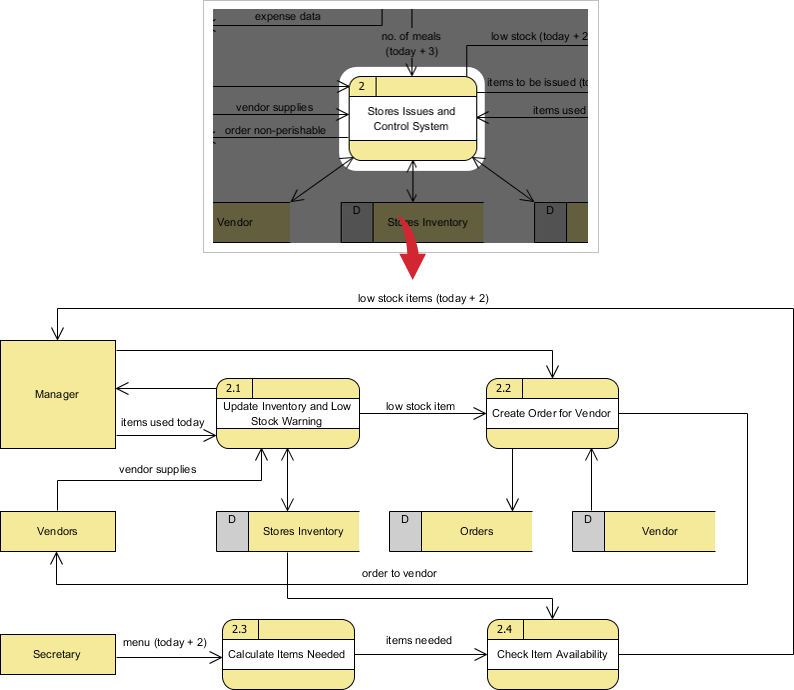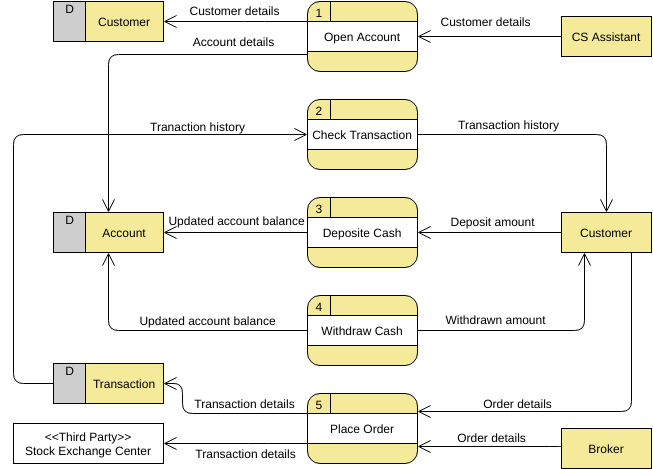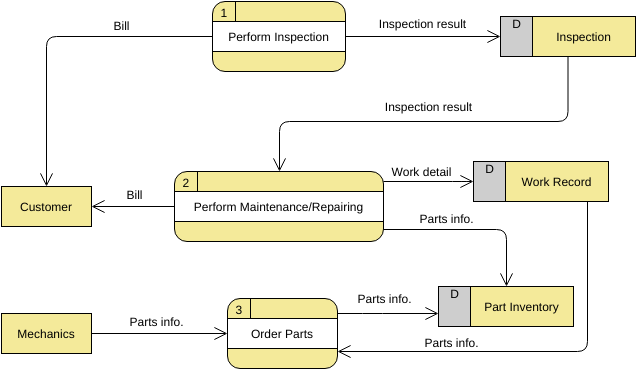Diagram konteks sistemdiagram konteks sistem (juga dikenal sebagai level 0 DFD) adalah tingkat tertinggi dalam diagram aliran data dan hanya berisi satu proses yang mewakili seluruh sistem yang menetapkan konteks dan batasan sistem yang akan dimodelkan. Ini mengidentifikasi aliran informasi antara sistem dan entitas eksternal, yaitu aktor.
Diagram konteks biasanya disertakan dalam dokumen persyaratan. Ini harus dibaca oleh semua pemangku kepentingan dan oleh karena itu harus ditulis dalam bahasa yang sederhana agar pemangku kepentingan dapat memahami proyek.
Berikut adalah contoh diagram konteks untuk Sistem Pesanan Penjualan:

Tujuan dari diagram konteks sistem
Tujuan dari diagram konteks sistem adalah untuk memfokuskan perhatian pada faktor dan peristiwa eksternal yang harus dipertimbangkan saat mengembangkan seperangkat persyaratan dan batasan sistem. Peta konteks sistem sering digunakan di awal proyek untuk menentukan ruang lingkup penyelidikan.
Diagram konteks sistem mewakili semua entitas eksternal yang mungkin berinteraksi dengan sistem. Seluruh sistem perangkat lunak terlihat seperti satu proses. Diagram semacam itu menggambarkan sistem di tengah, tanpa rincian struktur internalnya, dikelilingi oleh semua entitas eksternal dan sistem interaktif di lingkungan.
Apa itu Dekomposisi Top-Down?
Dalam desain top-down, gambaran umum sistem dirancang, menentukan tetapi tidak merinci tingkat subsistem mana pun. Kemudian, setiap subsistem diperinci lebih lanjut, misalnya, kadang-kadang dibagi menjadi banyak tingkat subsistem yang berbeda, sehingga dapat mendekomposisi seluruh spesifikasi menjadi elemen dasar.
Tujuan utama dari desain top-down adalah untuk mendekomposisi sistem menjadi bagian-bagian yang lebih kecil untuk memahami subsistemnya. Setelah elemen dasar ini diidentifikasi, mereka dapat lebih mudah dibangun menjadi modul komputer. Setelah modul-modul tersebut dibangun, Anda dapat dengan mudah menyatukannya dan membangun seluruh sistem dari elemen-elemen individu ini.
Diagram Konteks Tingkat Atas
Diagram konteks memberikan gambaran umum dan merupakan tingkat tertinggi dalam diagram aliran data, hanya berisi satu proses yang mewakili seluruh sistem. Itu harus dibagi menjadi proses utama yang memberikan detail lebih besar dan setiap proses utama dapat dibagi lebih lanjut untuk memberikan lebih banyak detail.
- Semua entitas eksternal ditampilkan pada diagram konteks serta aliran data utama ke dan dari mereka.
- Diagram tersebut tidak mengandung penyimpanan data.
- Proses tunggal dalam diagram tingkat konteks, yang mewakili seluruh sistem, dapat diperluas untuk mencakup proses utama sistem dalam diagram tingkat berikutnya, yang disebut sebagai diagram 0.

Level 1 DFD
Proses dalam diagram 0 (dengan angka bulat) dapat diperluas lebih lanjut untuk mewakili rincian aktivitas pemrosesan. Contoh di bawah menunjukkan tingkat berikutnya ((Diagram 1) dari ledakan proses.
Perhatikan bahwa:
Meskipun level 1 DFD berikut hanya memiliki tiga proses, ada cukup banyak input dan keluaran dari proses ke entitas eksternal dan itu bisa berakhir dengan beberapa garis silang di antara mereka dalam diagram; untuk menghindari masalah ini, kita bisa menggunakan (tampilan utama dan tambahan) beberapa tampilan dari entitas eksternal yang sama dalam DFD.

Level 2 DFD
Jika ada proses dengan banyak aliran data yang menghubungkan antara beberapa entitas eksternal, kita bisa terlebih dahulu mengekstrak proses tertentu tersebut dan entitas eksternal yang terkait ke dalam diagram terpisah yang mirip dengan diagram konteks, sebelum Anda memperinci proses tersebut ke dalam level DFD yang terpisah; dan dengan cara ini Anda dapat memastikan konsistensi di antara mereka dengan lebih mudah.

Konsistensi Model DFD Antara Level
Saat melakukan dekomposisi top-down ke DFD ke DFD tingkat lebih rendah, input dan output harus dipertahankan antara level DFD. Misalnya, level n & n+1 harus memiliki input dan output yang sama.

Pelajari Lebih Lanjut melalui Contoh
Butuh inspirasi? Berikut adalah beberapa contoh Diagram Aliran Data untuk membantu Anda memulai.
Klik pada diagram untuk melihatnya, atau klik tombol edit untuk mulai mengedit.
(*Didukung oleh Visual Paradigm Online)












This post is also available in Deutsch, English, Español, فارسی, Français, 日本語, Polski, Portuguese, Ру́сский, Việt Nam, 简体中文 and 繁體中文.


















